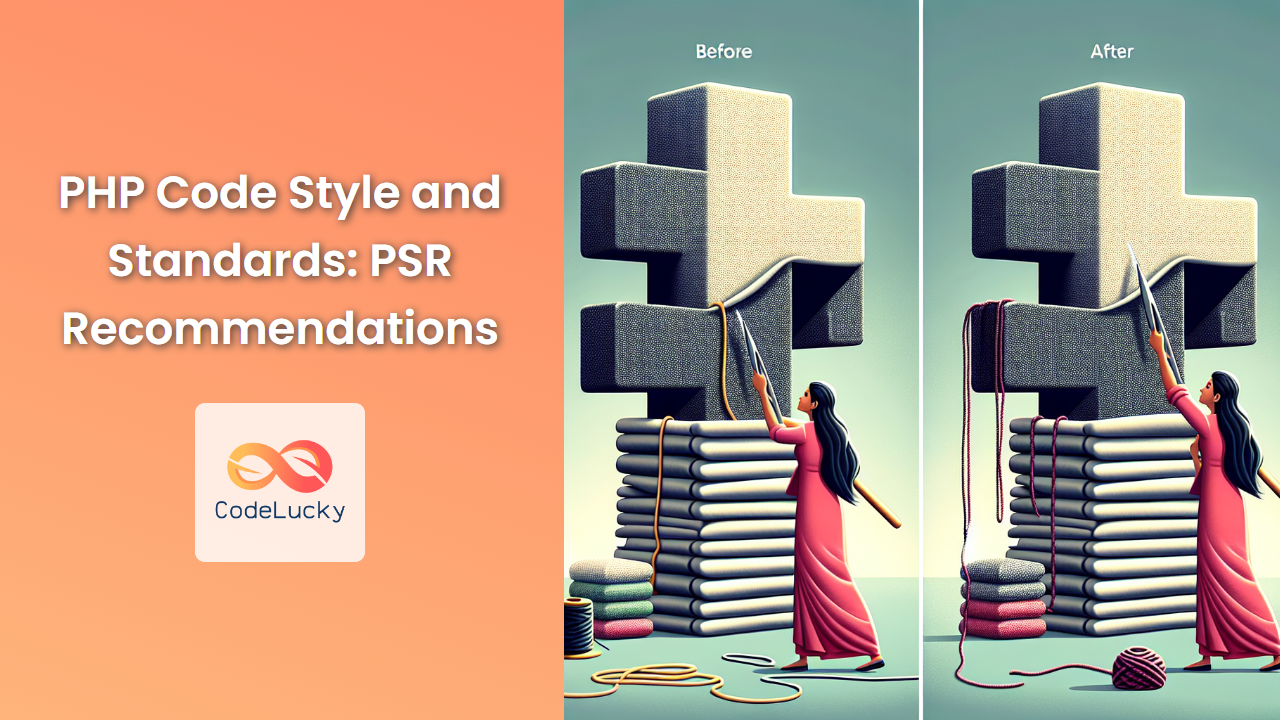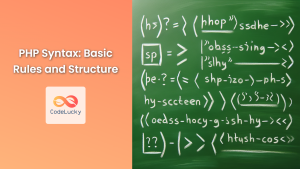In the world of PHP development, maintaining consistent and readable code is crucial for collaboration, maintainability, and overall project success. This is where PHP Standards Recommendations (PSR) come into play. PSR, developed by the PHP Framework Interop Group (PHP-FIG), provides a set of coding standards and best practices that help developers write clean, consistent, and interoperable PHP code.
In this comprehensive guide, we'll dive deep into the world of PSR, exploring its key recommendations and how they can elevate your PHP coding practices. We'll cover everything from basic coding style to more advanced concepts, complete with practical examples to illustrate each point.
What is PSR?
PSR stands for PHP Standards Recommendations. These are a set of PHP specifications and standards created by the PHP Framework Interop Group (PHP-FIG). The primary goal of PSR is to promote interoperability between PHP software projects and libraries.
🔑 Key Point: PSR is not just about making your code look pretty. It's about creating a common ground for PHP developers worldwide, making it easier to collaborate and maintain code across different projects and teams.
Why Should You Care About PSR?
Before we dive into the specifics, let's understand why PSR matters:
- Consistency: PSR ensures that code written by different developers follows a similar structure and style.
- Readability: By adhering to PSR, your code becomes more readable and understandable for other developers.
- Maintainability: Consistent code is easier to maintain and update over time.
- Interoperability: PSR makes it easier to integrate different PHP libraries and frameworks.
- Professionalism: Following industry standards demonstrates your commitment to quality and professionalism.
Now, let's explore some of the most important PSR recommendations and how to implement them in your PHP code.
PSR-1: Basic Coding Standard
PSR-1 lays the foundation for PHP coding standards. It covers the most basic elements of PHP coding style.
1. PHP Tags
Always use the full PHP tags <?php ?> or the short-echo syntax <?= ?>. Never use short tags like <? ?>.
<?php
// Your PHP code here
?>
<?= $variable ?> // Short echo syntax
2. Character Encoding
Files MUST use only UTF-8 without BOM (Byte Order Mark) for PHP code.
3. Class Names
Class names MUST be declared in StudlyCaps.
<?php
class UserProfile
{
// Class content
}
4. Class Constants
Class constants MUST be declared in all upper case with underscore separators.
<?php
class UserProfile
{
const MAX_NAME_LENGTH = 50;
const DEFAULT_STATUS = 'ACTIVE';
}
5. Method Names
Method names MUST be declared in camelCase.
<?php
class UserProfile
{
public function getUserName()
{
// Method content
}
public function setUserStatus($status)
{
// Method content
}
}
🔍 Pro Tip: Consistency in naming conventions makes your code more predictable and easier to navigate. It's like having a well-organized filing system for your code!
PSR-2: Coding Style Guide
PSR-2 expands on PSR-1 and provides a more comprehensive set of coding style rules. Let's look at some key aspects:
1. Indentation
Use 4 spaces for indentation, not tabs.
<?php
function calculateTotal($items)
{
$total = 0;
foreach ($items as $item) {
$total += $item->getPrice();
}
return $total;
}
2. Line Length
Lines SHOULD be 80 characters or less. The hard limit on line length is 120 characters.
3. Keywords and True/False/Null
PHP keywords MUST be in lower case. The constants true, false, and null MUST be in lower case.
<?php
if (true) {
// Do something
} elseif (false) {
// Do something else
} else {
// Default action
}
$result = null;
4. Namespace and Use Declarations
There MUST be one blank line after the namespace declaration, and there MUST be one blank line after the block of use declarations.
<?php
namespace Vendor\Package;
use FooClass;
use BarClass as Bar;
use OtherVendor\OtherPackage\BazClass;
// Your code starts here
5. Class, Method, and Function Declarations
The opening brace for classes MUST go on the next line, and the closing brace MUST go on the next line after the body.
<?php
class ClassName extends ParentClass implements \ArrayAccess, \Countable
{
public function fooBarBaz($arg1, &$arg2, $arg3 = [])
{
// method body
}
}
🎨 Style Note: Think of your code as a painting. PSR-2 provides the canvas and basic color palette. Your unique coding style is the masterpiece you create within these guidelines!
PSR-4: Autoloader
PSR-4 specifies the standards for autoloading classes from file paths. It replaces the older PSR-0 autoloading standard.
Key Points of PSR-4:
-
Fully-qualified class names MUST have the following structure:
\<NamespaceName>(\<SubNamespaceName>)*\<ClassName> -
Each namespace must have a base directory.
-
Class names MUST correspond to file names, with the
.phpextension.
Let's see an example of a PSR-4 compliant directory structure:
vendor/
codelucky/
blog/
src/
Post.php
Comment.php
tests/
PostTest.php
CommentTest.php
In this structure, the namespace for the Post class would be:
<?php
namespace CodeLucky\Blog;
class Post
{
// Class implementation
}
And you would use it like this:
<?php
use CodeLucky\Blog\Post;
$post = new Post();
🚀 Autoloading Magic: PSR-4 autoloading is like having a personal assistant for your code. It knows exactly where to find each class, saving you from manual include or require statements!
PSR-12: Extended Coding Style Guide
PSR-12 is an extension and replacement for PSR-2. It builds upon PSR-1 and PSR-2, adding more modern PHP features and practices.
1. Declare Statements, Namespace, and Import Statements
<?php
declare(strict_types=1);
namespace Vendor\Package;
use Vendor\Package\{ClassA as A, ClassB, ClassC as C};
use Vendor\Package\SomeNamespace\ClassD as D;
use function Vendor\Package\{functionA, functionB, functionC};
use const Vendor\Package\{ConstantA, ConstantB, ConstantC};
2. Class and Method/Function Declarations
<?php
class ClassName
{
public function fooBarBaz(
string $arg1,
?string $arg2,
?string $arg3 = null
): ?string {
// method body
}
}
3. Control Structures
PSR-12 provides detailed guidelines for control structures. Here's an example of a compliant if-elseif-else structure:
<?php
if ($expr1) {
// if body
} elseif ($expr2) {
// elseif body
} else {
// else body;
}
4. Traits
PSR-12 introduces guidelines for using traits:
<?php
trait FooTrait
{
public function someMethod()
{
// method body
}
}
class ClassName
{
use FooTrait;
}
🧩 Trait Trivia: Traits are like LEGO blocks for your classes. PSR-12 ensures you're assembling them correctly in your PHP code!
Practical Example: Putting It All Together
Let's create a simple blog post management system that adheres to PSR standards. We'll create a Post class and a PostManager class.
First, let's set up our directory structure:
src/
Blog/
Post.php
PostManager.php
Now, let's create our Post class (src/Blog/Post.php):
<?php
declare(strict_types=1);
namespace CodeLucky\Blog;
class Post
{
private int $id;
private string $title;
private string $content;
private \DateTime $createdAt;
public function __construct(int $id, string $title, string $content)
{
$this->id = $id;
$this->title = $title;
$this->content = $content;
$this->createdAt = new \DateTime();
}
public function getId(): int
{
return $this->id;
}
public function getTitle(): string
{
return $this->title;
}
public function getContent(): string
{
return $this->content;
}
public function getCreatedAt(): \DateTime
{
return $this->createdAt;
}
}
Now, let's create our PostManager class (src/Blog/PostManager.php):
<?php
declare(strict_types=1);
namespace CodeLucky\Blog;
class PostManager
{
private array $posts = [];
public function addPost(Post $post): void
{
$this->posts[$post->getId()] = $post;
}
public function getPost(int $id): ?Post
{
return $this->posts[$id] ?? null;
}
public function getAllPosts(): array
{
return $this->posts;
}
}
Finally, let's create a script to use these classes:
<?php
declare(strict_types=1);
require_once 'vendor/autoload.php';
use CodeLucky\Blog\Post;
use CodeLucky\Blog\PostManager;
$postManager = new PostManager();
$post1 = new Post(1, 'First Post', 'This is the content of the first post.');
$post2 = new Post(2, 'Second Post', 'This is the content of the second post.');
$postManager->addPost($post1);
$postManager->addPost($post2);
$retrievedPost = $postManager->getPost(1);
if ($retrievedPost !== null) {
echo "Retrieved Post:\n";
echo "ID: " . $retrievedPost->getId() . "\n";
echo "Title: " . $retrievedPost->getTitle() . "\n";
echo "Content: " . $retrievedPost->getContent() . "\n";
echo "Created At: " . $retrievedPost->getCreatedAt()->format('Y-m-d H:i:s') . "\n";
} else {
echo "Post not found.\n";
}
echo "\nAll Posts:\n";
foreach ($postManager->getAllPosts() as $post) {
echo $post->getTitle() . "\n";
}
This example demonstrates several PSR recommendations:
- PSR-1 and PSR-12 coding styles (class names, method names, indentation)
- PSR-4 autoloading (namespace structure matching directory structure)
- Type declarations (introduced in PHP 7)
- Strict typing (introduced in PHP 7)
📊 Output:
When you run this script, you should see output similar to this:
Retrieved Post:
ID: 1
Title: First Post
Content: This is the content of the first post.
Created At: 2023-06-15 10:30:45
All Posts:
First Post
Second Post
🎉 Congratulations! You've just created a simple blog post management system that adheres to PSR standards. This code is clean, consistent, and easy for other PHP developers to understand and maintain.
Conclusion
Adopting PSR recommendations in your PHP projects is a game-changer. It not only makes your code more readable and maintainable but also aligns your coding practices with industry standards. Remember, PSR is not about restricting your creativity as a developer. Instead, it provides a solid foundation upon which you can build robust, efficient, and beautiful PHP applications.
As you continue your PHP journey, make it a habit to refer back to PSR guidelines. Over time, writing PSR-compliant code will become second nature, and you'll find yourself producing higher quality code with less effort.
Happy coding, and may your PHP adventures be filled with clean, consistent, and PSR-compliant code! 🚀💻



















